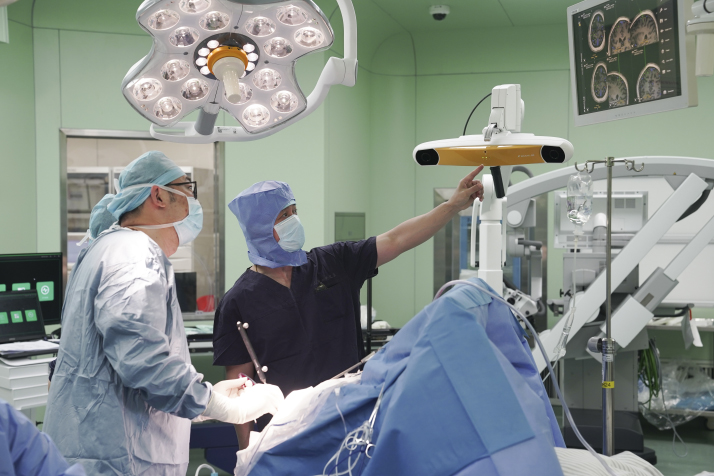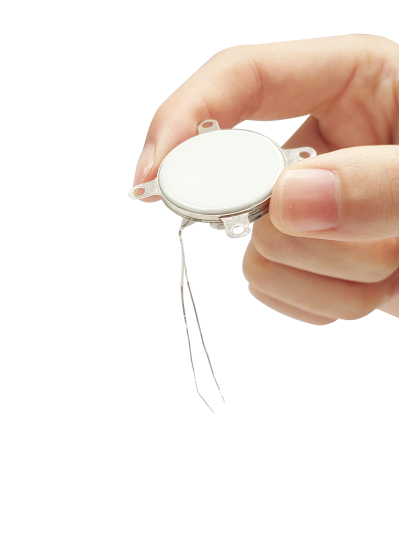| China |
| China's brain-computer interface trials unlock new frontiers in neurotechnology | |
|
|
 Professors from Huashan Hospital affiliated with Fudan University in Shanghai perform brain-computer interface operation on the first clinical trial patient on March 25 (XINHUA)
With a tiny, coin-sized device implanted in his brain, one 37-year-old man, who lost all four limbs in a horrific high-voltage accident 13 years ago, can now type messages, send texts and even play video games using nothing but his thoughts. The miracle was achieved after a brain-computer interface (BCI) operation and three weeks of adaptive training. The achievement was made as part of China's first successful invasive BCI clinical trial, making China the second country after the United States to reach this stage, following Neuralink's human trial in January 2024. Cracking the brain's code The groundbreaking procedure was led by researchers from the Beijing-based Center for Excellence in Brain Science and Intelligence Technology (CEBSIT) of the Chinese Academy of Sciences in partnership with Shanghai-based Huashan Hospital affiliated with Fudan University. The implanted device, developed by the team, is just 26 mm in diameter and under 6 mm thick—half the size of Neuralink's and currently the world's smallest brain-controlled implant. Unlike traditional brain surgeries that require removing large sections of the skull, this procedure was minimally invasive. Surgeons thinned a small, coin-sized area of the skull above the motor cortex, then made a 5-mm puncture to thread in ultra-thin, ribbon-like electrodes. "This is essentially a minimally invasive neurosurgery," Lu Junfeng, principal investigator of the team from Huashan Hospital, told People's Daily newspaper. "The technique has been refined over a decade in China's neurosurgical centers—it's mature, safe and cost-effective. The entire implantation takes about 20 to 30 minutes." The marvel lies in the flexible electrodes. The team revealed that the electrodes are about 1 percent of the diameter of a human hair, with a cross-section just around one seventh to one fifth the size of Neuralink's. They're also 100 times more flexible, allowing them to integrate seamlessly into brain tissue without triggering damage or inflammation. Pu Muming, a member of the Chinese Academy of Sciences and Director of the CEBSIT, told People's Daily that global BCI research has spanned nearly 30 years. However, before Neuralink's emergence, scientists consistently faced three major technological bottlenecks: device miniaturization, system integration and wireless signal transmission. In the past, patients had to wear heavy metal headgear to establish connections between their brains and external devices for signal transmission and control. According to Zhao Zhengtuo, head of the research team, the CEBSIT officially launched its BCI system development in 2022. The team overcame numerous technical challenges, and ultimately obtained China's first invasive BCI registration test report in the second half of 2024. Zhao detailed the meticulous participant selection process for the clinical trials. "The trial focuses on patients with complete spinal cord injuries or bilateral upper-limb amputations," he told Xinhua News Agency. "Our selection criteria prioritize candidates based on the severity of their motor impairment, specifically targeting individuals who stand to gain the most significant quality-of-life improvements from BCI technology." The research team employs advanced neuroimaging techniques in preoperative planning, combining functional MRI with high-resolution CT scans to create personalized 3D models of each patient's motor cortex. These detailed neural maps enable millimeter-precise electrode implantation, optimizing the interface between device and brain tissue. Implantation is just the first step—the real technological challenge lies in real-time neural signal decoding. This requires establishing a millisecond-level high-precision closed-loop control system and achieving dynamic adaptation between the decoding algorithm and the user's neural characteristics. "The breakthrough in AI technology has significantly advanced BCI applications," Nyx Xiyujin He, a partner of BrainCo, a BCI company based in Hangzhou, Zhejiang Province, said during her speech at the Global Health Forum of the Boao Forum for Asia in Beijing on July 24. "It has been a century since Dr. Hans Berger in Germany first recorded electrical signals from the human cerebral cortex in 1924. Yet progress remained painstakingly slow for decades because the brain was—and in many ways still is—a black box. With 86 to 100 billion neurons working in concert, deciphering their precise functions and meanings was nearly impossible with earlier technologies." she said. "Now, with AI technology, we can finally decipher the brain's neural coding. This not only drives BCI development but also brings new possibilities for treating brain-related disorders." The team's breakthrough came from their self-developed "brain language translator," an AI-powered system that continuously adapts to the brain's ever-shifting signals. Whether the user is tired, focused or in a different mood, the system learns on the fly, ensuring smooth, stable control—day after day.  Photo taken on March 22 shows an invasive brain-computer interface device developed by the Center for Excellence in Brain Science and Intelligence Technology of the Chinese Academy of Sciences in Beijing (XINHUA)
From lab to life Research team leader Zhao noted that there is still a relative lack of clinical trial data for brain-computer interfaces at present, and the implanted devices cover only limited areas of the brain, making it currently impossible to achieve whole-brain coverage for tasks such as whole-brain language decoding. In the next phase, the research team will enable subjects to use robotic arms to perform real-world tasks such as grasping objects and holding cups. Later stages will involve controlling more complex external devices, such as robotic dogs and embodied AI agents, further expanding users' capabilities and autonomy in daily life. Zhao revealed that upon regulatory approval, the BCI system will primarily serve three patient groups: those with complete spinal cord injuries, double-arm amputees and individuals with amyotrophic lateral sclerosis (ACS). By reconstructing motor function control, the technology is expected to tangibly improve their quality of life. BrainCo's partner He emphasized the strategic value of BCI. "This stems from the vast unmet need in treating brain disorders, from depression to age-related Alzheimer's, where effective therapies remain lacking. AI-powered BCI could bring transformative breakthroughs," she said. She believes BCIs could fundamentally transform how humans interact with the world. "From a neuroscience perspective, all our interactions with the world ultimately boil down to neural signals," she said. "Everything we see, hear, smell or touch gets converted into electrical impulses in the brain—including our own responses. BCIs, by directly interfacing with these signals, have the potential to radically reshape how we engage with people, the physical world, and even AI systems. That's why this is such a groundbreaking technology worth promoting." However, she notes that public understanding of BCIs remains limited—and often polarized. Some mythologize the technology, assuming it can do anything, believing in consciousness uploading or instant knowledge implantation. Others swing to the opposite extreme, fearing BCIs could steal their thoughts or even control their minds. "Establishing a scientific, rational public understanding is crucial for responsible adoption," she said. Copyedited by G.P. Wilson Comments to yuanyuan@cicgamericas.com |
|
||||||||||||||||||||||||||||
|